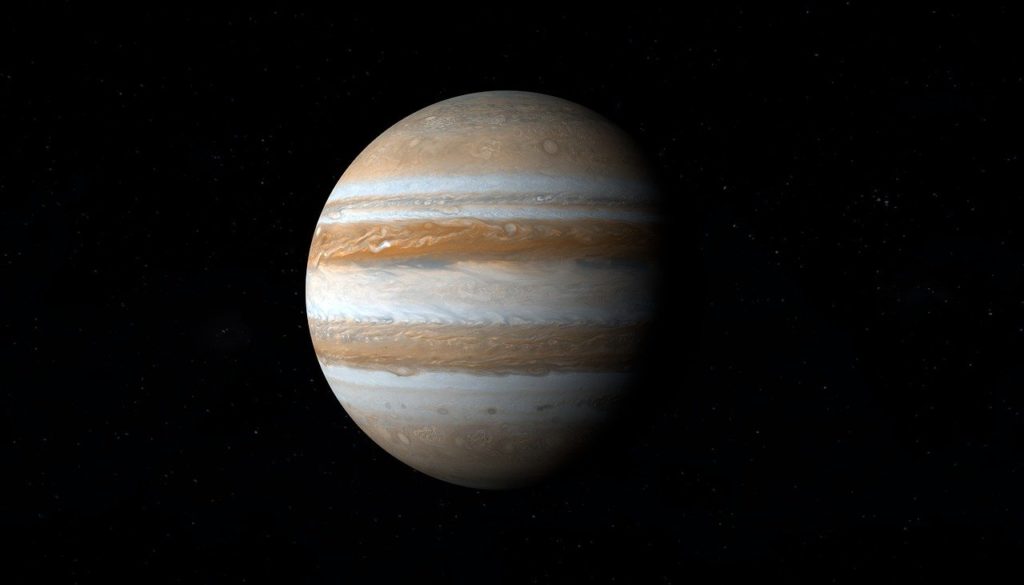Jupiter is the largest planet in our Solar system. It is the fifth planet from the Sun and it beats other planets in pretty much every size aspect. Let’s learn some interesting facts about Jupiter.
Facts about Jupiter (everything you need to know)
Orbit of Jupiter
- Jupiter orbits at a distance of 484 million miles (average) from the Sun. 484 million miles is approximately equal to 5.2 Astronomical Units (AU). 1 Astronomical Unit is the average distance of Earth from the Sun. In other words, the distance of Jupiter from the Sun is 5.2 times the distance of Earth from the Sun.
484 million miles = 778 million kilometers = 5.2 AU
- Jupiter takes 4,333 Earth days to complete one revolution around the Sun. However, Jupiter’s rotation speed is quite high. It completes one rotation around its axis in just 9.93 hours.
1 Jupiter year = 11.9 Earth years
1 Jupiter day = 0.4 Earth days

Physical Overview of Jupiter
- Jupiter is a gas giant. It does not have a true surface. The atmosphere of Jupiter is mainly made up of Hydrogen and Helium.
- Very little is known of Jupiter’s core. It may be a solid one or a very hot, molten diffuse core.
- The average density of Jupiter is one-fourth of Earth’s average density.
Jupiter’s average density = 1,326 kg / m3
Earth’s average density = 5,514 kg / m3
- Jupiter is 318 times heavier than Earth.
Mass of Jupiter = 1,898.19 × 10^24 kg
Mass of Earth = 5.9724 × 10^24 kg
- Jupiter’s rotational axis is tilted at an angle of 3.13 degrees with respect to its orbital axis. Our Earth’s rotational axis is tilted at an angle of 23.5 degrees.
- Jupiter is 11 times wider than Earth.
Mean radius of Jupiter = 69,611 km
Mean radius of Earth = 6,371 km
- Jupiter was twice its current size during the formation. In fact, it is estimated that the planet is still shrinking by about 2 cm every year.
- Jupiter’s famous Great Red Spot is a huge oval-shaped storm, twice as wide as Earth. The storm is persistent as there is a lack of surface to slow it down. It has been observed for over 300 years now.
- Jupiter’s mass is about 1/1000 that of the Sun and its radius is about 1/10 that of the Sun.
Jupiter’s mass = 1,898.19 × 10^24 kg
Sun’s mass = 1,988,500 × 10^24 kg
Jupiter’s mean radius = 69,611 km
Sun’s mean radius = 695,700 km
Rings of Jupiter
Like Saturn, Jupiter also has rings around it. Jupiter’s rings are however very faint as they are mainly composed of dust. The Voyager 1 discovered the rings in 1979 when it looked back at Jupiter while moving towards Saturn. The rings are only visible when viewed from behind Jupiter and towards the Sun.
Natural satellites/Moons of Jupiter
Jupiter has 95 known moons. It is the planet with the second-highest number of moons after Saturn. Ganymede is the largest moon of Jupiter. It is also the largest moon in our Solar system. Interestingly, Ganymede is even bigger in diameter than Mercury. However, it is lighter with a mass of about 45% that of Mercury. The four largest moons of Jupiter are Ganymede, Callisto, Io, and Europa.

Jupiter vs Earth comparison
| Jupiter | Earth | |
|---|---|---|
| Radius | 69,911 km (43,440 miles) | 6,371 km (3,959 miles) |
| Mass | 1,898.19 × 10^24 kg | 5.9724 * 10^24 kg |
| Planet type | Gas giant | Terrestrial |
| Position from the Sun | 5th | 3rd |
| Day length | around 9.93 hours | around 23.9 hours |
| Year length | around 4,333 Earth Days | 365.25 days |
| Time taken by sunlight to reach | around 43 minutes | around 8 minutes 20 seconds |
| Average distance from the Sun | around 778 million kilometers (484 million miles) | around 150 million kilometers (93 million miles) |
| Ring System | Yes | No |
Additional facts about Jupiter
- Jupiter is one of the five planets visible to the naked eye. Mercury, Venus, Mars, Jupiter, and Saturn are visible from Earth.
- Jupiter is the fourth brightest natural object in the sky. The top five brightest natural objects are Sun, Moon, Venus, Jupiter, and Mars.
- Jupiter was named after the Roman God of the sky and lightning.
- 9 spacecraft have visited Jupiter – Pioneer 10, Pioneer 11, Voyager 1, Voyager 2, Galileo, Ulysses, Cassini-Huygens, New Horizons, and Juno.
- More than 1,300 Earths could fit inside Jupiter.
- Jupiter is the fastest-spinning planet in the solar system.
Quick question
Where is the main asteroid belt located?
Read more
Answer to quick question
The main asteroid belt is located between Mars and Jupiter. The asteroid belt contains various irregular-shaped solid objects.